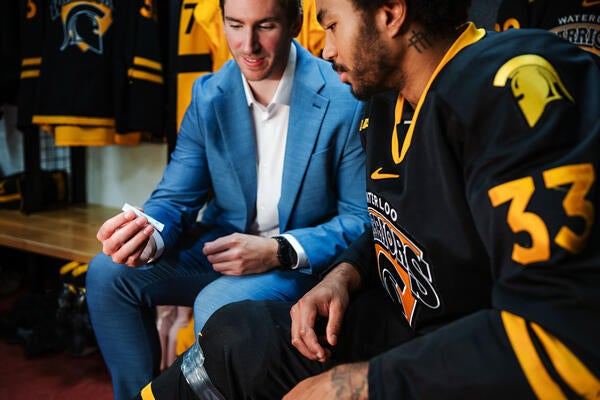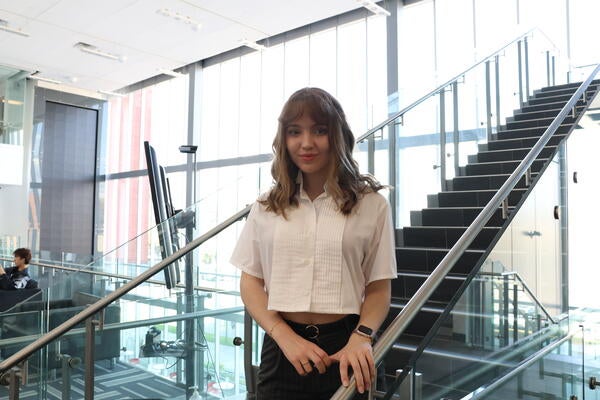
Engineering student design teams win $50,000 each to launch startups
Waterloo Engineering alumni Chamath Palihapitiya and Brigette Lau launched venture fund to support new engineering grads with promising ideas

Waterloo Engineering alumni Chamath Palihapitiya and Brigette Lau launched venture fund to support new engineering grads with promising ideas
By Brian Caldwell Faculty of EngineeringWith a deadline approaching to commit to their fourth-year Capstone Design project, friends Phil Cooper and Michael Phillips were torn between two ideas: one of them relatively straightforward and the other extremely ambitious.
They were still undecided when they went to listen to Chamath Palihapitiya, the celebrated Silicon Valley venture capitalist and Waterloo Engineering alumnus, as he urged students to set aside their fear of failure during an appearance on campus in September.
That was it, the inspiration they needed to go for it instead of playing it safe.
Six months later, Cooper and Phillips are the recipients of one of two $50,000 awards from Palihapitiya and his wife Brigette Lau, also an accomplished Waterloo Engineering graduate, to pursue their student project as a business startup called Vena Medical after graduation this spring.
“Hearing what he had to say, we decided we had to take the risk on this very intense project,” recalls Phillips, 22, of Sussex, New Brunswick. “We understood it was going to be a ton of work, but the return was so much higher.”
Also in the audience as Palihapitiya fielded questions from Dean Pearl Sullivan during an informal chat were John Grousopoulos and Chris Hajduk, two members of the other team to win $50,000 in backing through the Palihapitiya/Lau Venture Creation Fund.
Both teams will work in Kitchener-Waterloo for at least four months after graduation on promising medical technology, one of the key fields Palihapitiya and Lau focus on with their own company, Social Capital.
“I feel like all of our trials, troubles and failures have been okayed, they’ve been validated,” says Grousopoulos, 22, of Kitchener.
Here is a look at the two winning teams, their projects and their goals:

Michael Phillips and Phil Cooper
Cooper and Phillips, both sons of medical doctors, bonded while struggling with linear algebra in their first year of mechanical engineering.
They call their project SWIRVE – an acronym for shortwave infrared vascular endoscope – and have personal connections to it through their fathers: one suggested it and the other could have benefitted from it after developing a clot in his leg.
Endoscopes, which allow doctors to see inside the human body via tiny cameras, are already widely used for procedures such as colonoscopies.
Cooper and Phillips aim to give doctors the same ability in the field of interventional radiology so they can accurately position catheters inside arteries for procedures such as removing clots and implanting stents.
The problem: coming up with a tool that is both small enough to be snaked through arteries and capable of seeing through blood.
The solution: a fibre optic cable, or scope, that uses infrared light at a particular wavelength to illuminate the inside of an artery, then transmits images back to a camera and a monitor outside the body.
At the moment, surgeons in the field must rely on two-dimensional x-rays, or fluoroscopes, to manoeuvre guidewires through arteries, a less precise method that also exposes patients to radiation.
“The big issue is they have no navigational perspective,” says Cooper, 22, of Pembroke, Ontario.
Working out of the Velocity Science incubator on campus, the teammates have so far developed a prototype of a fibre optic bundle that can see through water.
If testing shows it can also see through blood, they must then make it much thinner and add expensive metal cladding so it is as manoeuvreable as the guidewires currently in use.
Getting to this point took two to three times as much work as recommended for Capstone projects, including a trip to a London hospital to scrub in and watch surgeons in action.
“We have a long way to go, but we’re still excited about it,” says Cooper.

John Grousopoulos, Mostafa Saquib and Chris Hajduk
Grousopoulos, Hajduk and Mostafa Saquib (a fourth member, Pablo Enrique, also worked on the student project, but is not part of the startup) trace their success to a crazy idea floated during marathon brainstorming sessions.
His fellow nanotechnology engineering students laughed when Grousopoulos suggested they try to find a way for people to breathe underwater without using scuba tanks.
But out of that wild flyer somehow developed a concept that could change the lives of people who need oxygen therapy for conditions such as chronic obstructive pulmonary disease, cystic fibrosis and lung cancer.
Existing devices typically require patients to wheel around 10 to 20 pounds of equipment when they leave their homes and are limited to about two to three hours, either by oxygen supply or battery life.
Also based at Velocity Science, the startup formed by the three friends, VivaSpire, has ambitious plans to give people more freedom with portable devices that are much lighter and longer-lasting.
Ultimately, they aim to develop sleek, wearable technology.
“Imagine something people can wear and it’s so light and unobtrusive that it’s almost like clothing,” says Grousopoulos.
At the core of the concept is an oxygen-absorbing material reduced to a nanoscale (a nanometre is one billionth of a metre) powder, dramatically increasing its efficiency because of greater surface area.
A proof of concept prototype has shown the powder can both absorb oxygen from air and release it again when heated.
Significantly, the air need not be pressurized, eliminating heavy compressors and batteries that largely contribute to the weight and bulk of existing portable devices.
The challenge now is using that powder – which Hajduk, 22, of Guelph, describes as their “secret sauce” – to make smaller, lighter systems and, eventually, housing it in thin, flexible units that could be worn like a belt or an undershirt.
Money from the fund will be used to try to develop a working prototype, a key step on what VivaSpire members realize will be a long journey.
“The more research we did, the more committed we became because we understood how big of a problem it is,” says Saquib, 21, of Kitchener. “We want to make something that’s useful and doesn’t just stay within the university collecting dust.”

Read more
New medical device removes the guesswork from concussion screening in contact sports using only saliva

Read more
Waterloo student launches Colare through co-op and entrepreneurship programs to reimagine recruitment for engineers

Read more
Fourth-year Global Business and Digital Arts student leverages artificial intelligence to fight food inflation, saving families up to $5,000 each year
Read
Engineering stories
Visit
Waterloo Engineering home
Contact
Waterloo Engineering
The University of Waterloo acknowledges that much of our work takes place on the traditional territory of the Neutral, Anishinaabeg, and Haudenosaunee peoples. Our main campus is situated on the Haldimand Tract, the land granted to the Six Nations that includes six miles on each side of the Grand River. Our active work toward reconciliation takes place across our campuses through research, learning, teaching, and community building, and is co-ordinated within the Office of Indigenous Relations.